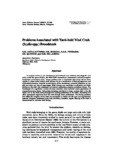Problems associated with tank-held mud crab (Scylla spp.) broodstock
- Global styles
- MLA
- Vancouver
- Elsevier - Harvard
- APA
- Help

Download URL
www.asianfisheriessociety.orgDate
2001Page views
1,944AGROVOC keyword
Metadata
Show full item record
Share
Abstract
To support studies on the development of broodstock and hatchery technology for mud crabs under the genus Scylla, the SEAFDEC Aquaculture Department maintains captive broodstock in land-based tanks. Disease problems seen in broodstock after being held for three months in these tanks include shell disease due to a combination of fouling organisms and chitinoclastic bacteria, bacterial contamination of the hemolymph, parasitic infestation on the gills and shell, and loss of appendages. Shell disease was manifested as off-white and black patches on the shell, that progressed and became perforations exposing underlying tissues. The hemolymph of a significant number of newly recruited crabs harbored mixed populations of sucrose-fermenting vibrios. Pedunculate cirripedes were found in large numbers both in the gill region and on the shell, boring through and creating perforations in the latter. Nematodes and other saprophytic organisms enter the crab through these perforations. The fouling problems that affect the integrity of the shell are considered to reduce the life span and reproductive potential of captive broodstock under tank conditions; therefore, regular cleaning of the shell is recommended to minimize shell fouling.
Suggested Citation
Lavilla-Pitogo, C. R., Marcial, H. S., Pedrajas, S. A. G., Quinitio, E. T., & Millamena, O. M. (2001). Problems associated with tank-held mud crab (Scylla spp.) broodstock. Asian Fisheries Science , 14(2), 217-224. http://hdl.handle.net/10862/1903
Type
ArticleISSN
0116-6514Collections
- Journal Articles [1258]

